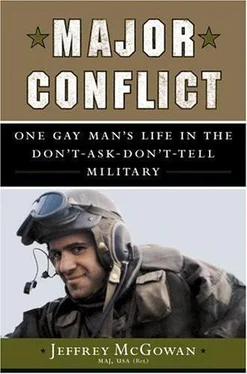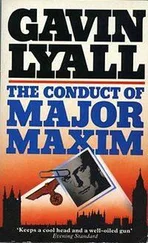A young soldier doesn’t make much money. There is an impression around the country that if you join the service you’ll get great pay, excellent benefits, and a good pension. This is a half truth, at best. First, the pay isn’t outstanding. On average it’s roughly 6.5 percent lower than civilian salaries. Second, the benefits are pretty good and there is a pension, but they lag far behind what can be had in the private sector. As a single guy on his own I never had a problem, but raising a family on army pay is no easy task. It’s troubling to me, especially now, when we’re asking so much of the members of our armed services, to see young servicemen and -women struggling to support their families, even sometimes having to go on welfare. Though the pay gap between military and civilian workers has decreased slightly over the past few years, and the imminent-danger pay for soldiers in combat has increased, there’s still a long way to go. I think it’s shameful that the men and women we ask to defend our country sometimes have to struggle to meet the basic needs of their families.
None of this was on my mind, however, when I arrived at Fort Sill on that hot afternoon at the end of June 1988. No, at that point everything was up. All the buckets were full. Fort Sill, Oklahoma, may not have looked like the setting for a Broadway musical, at least not one by Rodgers and Hammerstein, but I sure as hell felt as if I were in one. Everything was about possibility and hope. I’d yet to earn even an ounce of cynicism. Though the question of my sexuality had caused me some pain in college (and much more pain for Greg, though I was far too callow to be aware of the pain I’d caused him), I’d somehow managed to stuff the genie that Greg had nearly succeeded in freeing forcefully back into the proverbial bottle of my own denial. Not only did I get the genie bottled, it seemed as if the original seal had never been broken. I was a free man now, young, bursting with excitement, having realized a dream born so many years before in Jackson Heights. I was a soldier now. I was a lieutenant in the United States Army.
Like any young person who has had a dream come true, I saw only good things ahead of me. I couldn’t wait to get up in the morning so I could put on my uniform and go off to work. Everything was new and interesting and worth learning more about. To top it off, I was now getting a decent paycheck every two weeks, something I’d never experienced, even when I worked full time in the summers as a bookseller for Doubleday. Being on my own and supporting myself for the first time was a great feeling. I’d never before felt so independent, that it was only me calling the shots. It wasn’t just the paycheck that was fueling this, of course. Along with the tremendous pride I took in being a lieutenant there was also a certain amount of validation that came with it, the respectability that is automatically granted to soldiers. Everywhere I went, people acknowledged me because I wore the uniform, and this acknowledgment gave me a great sense of pride and power and responsibility. Though I had wanted to serve in the Airborne, I soon discovered that the Artillery has an illustrious history of its own and is, in fact, an excellent branch in which to serve. I’d done some research, but it wasn’t until we passed by Key Gate on the afternoon of my arrival in late June that I began truly to appreciate the unique role the Artillery has played and continues to play in the U.S. military. What remains of Key Gate are two sides of a large stone wall with an iron gate in the center. On the left side two large cannons are affixed to the wall, crisscrossing each other. To the left of the cannons are the words “Fort Sill, Oklahoma,” and to the right “Home of the Field Artillery.” A large, old cannon sits in front of the other side, beneath the words “Key Gate.” Within the fort itself the sides of the road are dotted with vintage artillery pieces, statues commemorating this war and that battle, and many generals and famous commanders, including Major General Philip H. Sheridan, who first staked the site of Fort Sill out of the Indian Territory in 1869, and the fort’s name-sake, Brigadier General Joshua W. Sill, who was killed in the Civil War. Everything was neatly manicured. It had the feel of a very old, very prestigious and historic country club. Passing by all of this history, as if I were touring a kind of outdoor military museum, it occurred to me at one point that I didn’t recognize quite a few of the cannons, rockets, and missiles on display. I wanted to get a closer look, so when the driver left me off in front of Snow Hall, where I was to sign in and get settled, I decided to take a walk around. Examining the artillery pieces more closely, I realized just how much the branch has changed over the centuries.
The Artillery is considered the senior branch of the army since the first unit constituted by the colonies was an Artillery battery. What Artillery is, basically, is an amazingly lethal weapons system. Its mission is this: “To destroy, neutralize, or suppress the enemy by cannon, rocket, and missile fire, and to help integrate all fire support assets into combined arms operations.” The cannons are assigned to the divisions and provide the critical, all-weather capability to engage the enemy with a wide range of munition types. They can be dropped from planes, lifted by helicopter, or simply rumble along with the tanks. The missiles can engage targets up to one hundred kilometers away. And the MLRS (Multiple Launch Rocket System) can blanket a one-square-kilometer piece of terrain with a thick cloud of white-hot shrapnel. These three systems in combination provide the generals in charge with the unmatched ability to reach out and target the enemy long before the tanks and infantry even arrive. Artillery has been responsible for roughly a quarter of all casualties in the last several conflicts in which the United States has been involved. What role does the soldier play within this massive system of lethal weaponry? It is his role to make sure these machines work properly, of course. The artilleryman is trained to, above all, “put steel on target.” Artillery is in many ways a thinking man’s branch of the army. Gunnery, the science of computing ballistic firing data, is more involved than, say, shooting an M16A2 rifle. It also requires a much broader view of the battlefield. It often falls to Artillery to help integrate all the supporting pieces on the battlefield. For instance, the artilleryman assigned to a battalion of infantry will coordinate all tactical air support, the engineers, and naval gunfire.
After walking around and checking out all the vintage artillery I finally entered Snow Hall to sign in and get myself settled. Fort Sill is a national historic landmark. It is also the only remaining active army installation of all the South Plains forts built during the Indian Wars. Any doubts I had as to why the place was considered worthy of historic landmark status were immediately put to rest when I walked into Snow Hall. The place has the feel and smell of a very old high school and isn’t very well lit. Newly minted lieutenants take classes here on everything from tactics to cannon gunnery. It was in these classrooms where I would learn everything I needed to know about being an artilleryman. It is also the place where new doctrine is developed and serves not only as the artillery training center for the United States but for the entire free world. Foreign militaries send their best officers to train alongside us, where they learn the staff-planning process at all levels and how to use equipment their own governments have, in many cases, purchased from ours. It exposes them to our values and helps to maintain friends and allies throughout the world. It works, though not everyone remains friendly. Libyan leader Muammar Qaddafi took the signal officer course here, but he’s far more the exception than the rule.
Читать дальше












